Sunglasses are a huge help to sailors that need to block out the sun’s harmful UV rays and reflected rays from the water’s surface. But what color lenses are best for sailing to block light?
The differences in lens color make an impact in blocking out light waves or allowing a clearer picture for visual acuity depending on your needs. After reading, you’ll be able to identify what colors work best for blocking out bright light and fit for your sailing goals.
You’ll want to find a pair of sunglasses that fit your needs on the water to block out UV rays, but also look good on your face. In addition, comfort is another quality to have since you don’t want an expensive pair that doesn’t fit right.
What Color Lenses Are Best for Sailing and Why

The lens color for sunglasses is the first feature you should look for when sailing. Darker colors, such as gray, blue, and brown are good for brighter days. Lighter colors such as yellow, amber, gold, and rose are better for low light such as fog.
Depending on your situation while sailing is ultimately going to help decide what color lens is right for you.
If you had to choose one without doing much research or needed something quickly, gray is the most universal tint to cover bases for light sensitivity.
Having a blue or green background through those lens colors is another good option to offer warmer colors.
Another factor to consider is prescription sailing sunglasses. A certain color might be better or worse depending on how much light you need to block out.
A lot of brands can customize a pair for you with lens tint such as blue tint, so they’ll need your prescription information sent to them.
Best Choices for You

While each person should find out what lens color is best for them, each color has a different purpose to help with light intensity. When checking out the top sunglasses brands, each will have what they recommend to be the best.
For example, copper-colored lenses that are used for sight fishing will be different from everyday use since they help with depth perception and contrast. Brown-colored lenses are great for seeing far ahead or for people that have eye fatigue.
- Gray lenses: Considered an “all-purpose” color that has little to no color distinction.
- Green lenses: Some argue it’s a step above gray, but offers a slightly different view.
- Copper lenses: Good for light or dark and with gray waters.
- Red lenses: Enhance contrast in certain conditions, which might cause difficulty to see other colors.
- Yellow lenses: Excellent for lower-light or overcast.
- Blue lenses: When used as a mirrored lens and a gray base tint, it is excellent for constant bright blue colors (such as the Caribbean).
- Brown lenses: These reduce glare, enhance contrast, and help with eye fatigue or other issues like degenerative eye diseases.
- Purple lenses: These offer the same benefits as blue, so this is mainly a preference.
Are Polarized Lenses Really Necessary?
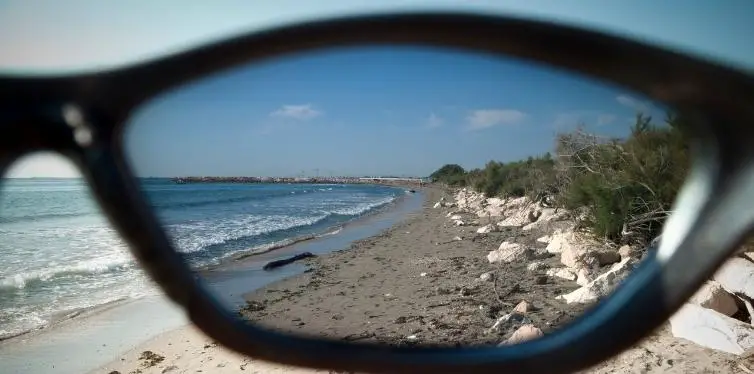
Having quality polarized lenses is absolutely necessary for those that are sensitive to the bright sun and want to block out ultraviolet rays.
Even if you’re not sensitive to bright lights, it’s still a good idea to protect your eyes from the sun’s rays with polarized sunglasses.
Polarized lens filters are great for reducing glare so you don’t squint as much. The only time when polarized lenses wouldn’t be ideal is if you constantly need to use LCD screens in your boat or have tinted windows.
The two polarized aspects interfere with one another, making it seem very dark inside or difficult to see out of.
Depending on the lens color you choose, it will come with a light transmission rate. This means how much light actually makes it to your eyes and helps you find the best lens tint you need.
In brighter conditions, you’ll want a lower transmission rate to help block out blue light. In low-light conditions, you’ll want a higher transmission rate typically with yellow lenses. Understanding the rates will affect what you choose for polarized lenses.
In addition, you’ll want to block out unfiltered glare that can impair your vision out on the water. This is light reflected on flat surfaces such as bright white decks, water, and even the sails.
Transmission Rates
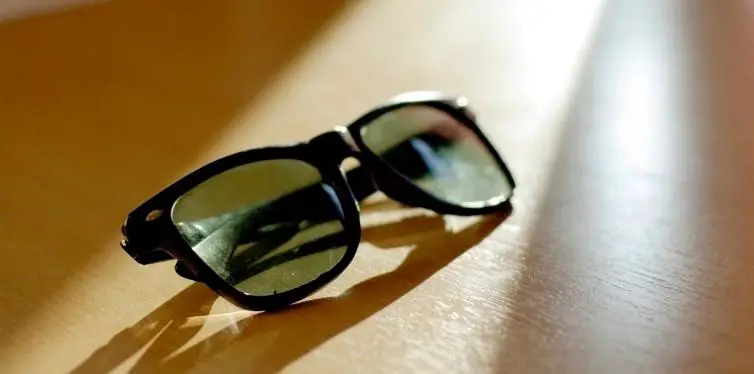
Most of the time sunglasses have their transmission rates in a percentage so you know their intended use.
This might be slightly different with prescription sailing sunglasses, as some brands might only offer a 13 to 30 percent transmission rate.
However, some brands simply use a number to describe visible light transmission rates.
Depending on how sensitive your eyes are can make a difference too when deciding on a pair of prescription glasses. As a general rule of thumb, use this list to determine which is best for blue light, low light, or your needs:
- Intense or bright: 9 to 12 percent
- Sunny or desirable conditions: 13 to 30 percent
- Overcast or haze: 31 to 55 percent
Mirror Coating
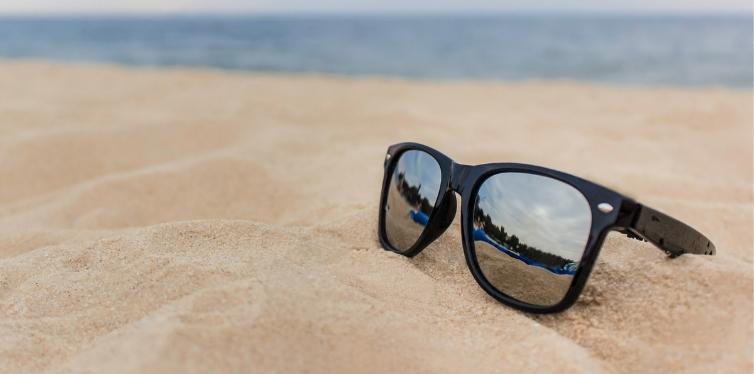
Mirrored coating or anti-reflective coating on sunglasses are another option you could choose to put on them.
Instead of standard polarized sunglasses, these reflect light away from your eyes.
They can come in any color, but most commonly in a silver mirror or green mirror.
Lens Shape and Lens Material: Why They Matter
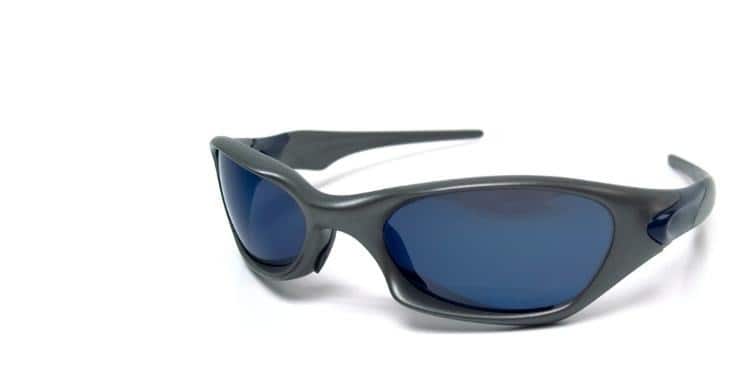
The shape of the lenses is all about what looks best on your face and is most comfortable. Just because a particular brand has a best seller with metal frames or cool spring hinges doesn’t mean it’s right for you. Some suggest that you should wear something opposite of your face shape.
For example, if you have a square face, then curved lenses are going to look best. However, you should likely just pick what you think works best or is appealing to you.
With something that you plan on keeping for a while, you want to make sure you like the way it looks.
When it comes to the material of your lenses, this is another good debate. Some glasses you can change the lenses out with another, but you will need to keep up with the other pair to obtain the benefits of both.
Photochromic lenses, or ones that change with light, are convenient when adjusting to the light such as ambient light.
The two materials you’ll have to worry about are glass and synthetic, such as polycarbonate or plastic lenses. Both offer great UV protection, can help with reducing glare or blue light, and can be used in a polarized lens.
Glass lenses offer the best views out of your glasses and are mostly scratch resistant, but have less stability upon impact when dropped. Polycarbonate lenses offer a good combination of clarity and eye protection, but scratch much easier.
How to Properly Clean Your Lenses
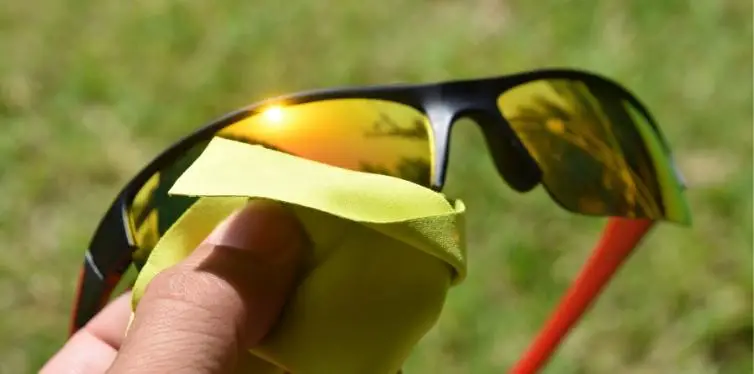
Taking care of your sailing sunglasses are necessary for long-term use. If you’re spending several hundred dollars on them, especially ones with polarized prescription lenses, you don’t want to be replacing them often.
If you don’t have a cleaning cloth specifically for sunglasses available, you’ll need to avoid using paper products. In addition, you cannot wipe them dry if you’ve been around saltwater.
Instead, simply use your breath to create moisture or run them under warm clean water to remove debris.
You can use a mild detergent, like dawn dish soap, to gently wash away salt water and even clean the nose pads. After that’s done, simply use a soft cloth to dry off.
Final Thoughts
There are plenty of color lenses to choose from when searching for the best sailing sunglasses.
Colors like gray and green might be a popular choice for many that want to improve light conditions, visual sharpness, or help with depth perception.
Materials like glass or polycarbonate have their pros and cons, but price might be a deciding factor as well as scratch resistance.
Whichever one you choose, you need to make sure you clean them regularly and properly to last for years.


